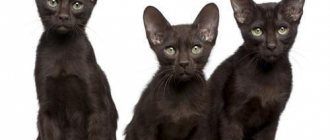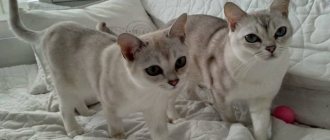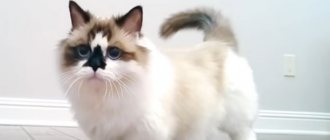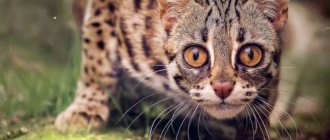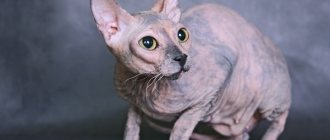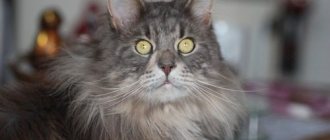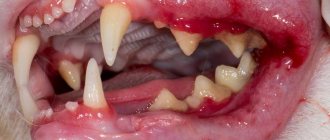The British marbled cat is considered one of the most ancient and beloved breeds. The animal has an interesting origin story. The future owner should familiarize himself with the standard of the reference representatives, know what shades of merle color exist, what is the character and health status of the cat. The owner also needs to master the skills of care and feeding, and if you plan to visit an exhibition, study the issues of reproduction.
According to breeders, a British merle cat is considered the most valuable and expensive among the representatives of its breed.
Where did the British come from?
The first ancestors from which the marbled Britons descended were brought to the territory of the British Isles from Rome and Egypt. The cats were distinguished by their powerful physique and high hunting instinct. The locals liked this because the cats began to destroy rodents that were spoiling the harvest. People and animals got along well, as cats had a proud disposition and unpretentiousness. For several centuries no one studied the breed. In 1889, an exhibition was held in London where the British white cat was presented. Real interest arose only in the 20-30s of the twentieth century, when, according to a program specially created by felinologists, they began crossing animals and breeding the breed. In 1980, the breed was recognized by the International Federation of Cat Fanciers. The marbled cat was bred through selection.
Interesting facts about tabby color
- According to the beliefs of many peoples of the world, tabby cats promise their owners good luck in all endeavors
: from love affairs to financial success; - There is an interesting legend regarding the origin of the name “tabby”
. Allegedly, the name of the color was given in honor of the Attabiya quarter of the Iraqi city of Baghdad, from where in the 17th-18th centuries. fabrics of amazing beauty with unusual moire patterns were supplied to English cities. Some people thought that the stripes on a cat’s fur coat looked like fabric patterns with fancy patterns; - Tabby color is considered the most ancient, natural color
. It was with these characteristic patterns that cats existed in ancient times. But they didn’t need the stripes for beauty, but for camouflage from potential victims and larger predators; - In the popular dream book of Felomena there is an explanation that seeing a striped cat in a dream
means unexpected luck or a date with a wonderful, unusual person; - Many felinologists and cat lovers believe that tabby-colored pets have the best health
. And all thanks to a special gene, which is responsible for the wild striped color, and is also directly related to the animal’s immunity; - All cats with red (red) and cream fur have stripes on their coats
. It’s just that sometimes they are not expressed too brightly, and therefore it seems as if the animal’s color is monochromatic and solid, but this is not so.
Description: what does the standard look like?
Variety of colors
The British Marble comes in a wide variety of colors, from black on silver to red.
The most famous color is black marble on silver, where the main tone is white-silver with a clear black pattern. In addition, cats of the British breed have the following colors:
- Gold marble (black marble on gold). There is a black and brownish pattern on a golden brown background.
- Chocolate marble. There are clear brown stripes against the café au lait background. The chocolate shade has varieties of silver (light base color and brownish pattern) and golden, where yellowish predominates in the shades.
- Blue marble. Includes a combination of dark and light gray.
- Red marble. This is a bright red cat with a characteristic pattern of a darker tone.
- Red silver marbled cats. They are distinguished by a light base color and light brown stripes.
Breed standard
The British marbled cat breed cannot have fold ears, so kinks in the ears are considered a deviation. Disadvantages include an incorrect bite, a narrow muzzle, a hump on the nose or a sign of brachycephalic breeds, and a pronounced pinch. Marbled kittens must be tabby, any baby from the litter must have short hair. The basic requirements for the breed are shown in the table:
| Body part | Characteristic |
| Body | Medium size, proportional, muscular |
| The chest is developed, the shoulders are wide, the back is straight | |
| Weight up to 8 kg | |
| Head | Rounded, cheeks pronounced |
| The nose is straight, the nose is large | |
| The transition from the forehead to the muzzle is pronounced, but not too obvious | |
| Ears | Small, pyramidal, widely spaced, rounded tips |
| Eyes | Round, wide open |
| Marble cats have a main shade of honey-yellow; cats with blue eyes come only in point color | |
| Paws | Thick, powerful, straight, rounded pads |
| Tail | Medium, thick, tapering to the tip |
| Wool | Short, loose fitting, thick |
| Undercoat present |
Life in the wild
Modern scientific observations of a rare species of felines are taking shape literally bit by bit. A lot of valuable data was obtained when a special chip was implanted in a wild-caught marbled cat in 2000. Episodic information is also obtained from video cameras that are installed in many reserves and record the life of the animals living there.
Rare footage from a surveillance camera
Where does the marbled cat live?
The favorite habitats of Pardofelis marmorata are impenetrable tropical forests, away from human paths and dwellings. But some small populations willingly settle in high mountainous rocky areas, where any vegetation is practically absent. The territory that one animal “superses” is about six square kilometers.
The marbled cat spends most of its life in trees
Lifestyle and character
Marbled cats are unsurpassed steeplejacks; they move much less often on the ground than on the branches of tall trees, flying up their trunks with lightning speed at the first need. Here, in the tree crowns, under the cover of dense foliage, a significant part of the marbled cat’s life takes place. She leads an exclusively nocturnal lifestyle, and during daylight hours she sleeps, sitting comfortably on the branches.
It is interesting that forest predators, unlike other felines, are exclusively ready to go down. At the same time, their movements are precise and swift, like those of squirrels.
She kind of looks like a squirrel, doesn't she?
Hunting is the main essence of the marbled cat; both its strong body and its entire way of existence are ideally suited for this activity. This ideal huntress can lie motionless for hours, like a statue, waiting for her prey to appear. But as soon as the right moment comes, the predator makes a killer throw - lightning fast and accurate; Almost all of her attacks are effective.
The marbled cat is also excellent at tracking down prey - here its excellent sense of smell and acute vision become its faithful assistants: the animal sees well in the dark.
Video: marbled cat walks through the forest
Nutrition
The diet of the marbled cat is very varied, and it supplements its menu by mainly hunting in the crowns of trees. Here, tree squirrels, bats, and, of course, various birds can become predator trophies. On occasion, she will not refuse to feast on other small prey: rodents, amphibians, reptiles and even large insects, which are found in abundance in the tropics.
The marbled cat hunts not only in the crowns of trees, but also in reed thickets
These cats have a good appetite - the daily diet of the predator reaches up to 0.8 kilograms in weight, which is approximately a sixth of the live weight of an adult animal.
Reproduction
These animals spend most of their lives alone: controlling the borders of their territory and protecting them from the invasion of strangers. But once a year, a marble cat and a female cat meet to indulge in the joys of love. And in this most important intimate matter, they also differ from most of their relatives. This species does not have a mating season determined by the time of year - a couple is formed when a mutual desire arises.
Lovers fill the tropical forest with romantic songs—loud guttural purrs; in normal times, these predators simply meow - just like the most common domestic pussy.
The season of love for marbled cats occurs at any time of the year.
In preparation for giving birth, the expectant mother cat begins to arrange a den in advance in which she will raise her offspring. The most inaccessible place for the nest is selected: in the hollow of an old tree or a cave hidden in dense grass thickets.
Pregnancy in a female lasts slightly longer than in other representatives of the cat family - up to 85 days. At the time prescribed by nature, blind, deaf and helpless kittens will be born - there are rarely more than four of them in a litter, and at first they look completely unmarbled. At birth, babies weigh no more than one hundred grams. And the first fur of newborn cubs has a uniform brownish tint; beautiful dark stains will appear on it much later, by four months.
By four months, the kitten's baby fur has completely changed to that of an adult.
Sexual maturity in young animals occurs at approximately two years. From this age they are ready to mate and give birth to offspring. How cubs are raised in nature and whether the father of the kittens is involved in this is unknown to zoologists today. The mother feeds the babies milk until they are two months old, then switches them to “adult” food, and at the same time teaches them all the intricacies of hunting and survival.
Main threats
The main risks for the existence of the marbled cat are human economic activity - deforestation and the development of the ancestral territories of the wild species.
The marbled cat's natural enemies are larger predators, mainly its fellow cats living in the same region. The wild Bengal cat, whose habitats often overlap in the marble cat, could compete in terms of food supply. But the first of the small predators hunts only on the ground, and the second - mainly on the upper tier of the tropical forest.
The masterly ability to climb trees helps not only to hunt, but also to escape from other predators.
Video: a selection of video surveillance from the reserve
Character and behavior
Pets prefer independence, so they do not like to be held, but keep their distance.
Marble British women are distinguished by restraint and prefer independence. That’s why they don’t tolerate being squeezed or picked up. The cat loves company, but sits close to family members alone. In the absence of the owner, he feels great and mostly sleeps. He has a high intelligence and his own opinion, therefore, if the pet is not raised from childhood, the character of British marbled cats can deteriorate. They are laconic, rarely meow and persistently ask for something. They are non-aggressive and balanced, but they remember insults for a long time and ignore the offender for a long time. They are very adamant in their decisions and intentions, so the owner should show restraint, affection and patience towards the pet.
Breeders recommend raising a British cat with marbled coloring from 1.5-2 months to 1 year. A sleeping animal should not be awakened, otherwise the cat will become irritable, so the breed is not suitable for families with small children. Has a tendency to do dirty tricks, so it is better to remove flower pots and expensive decorative items. They are curious, love to climb on closet shelves and “check” bags. There must be a scratching post in the room, otherwise the cat will ruin the furniture.
What is the difference between marble color
Several types of color fall under the “tabby” category, but marbled is distinguished from them by the presence of thick lines of contrasting color compared to the base color. In addition, the tail always has only 2 or 3 fairly wide stripes, while the brindle or spotted color has many of them, and they are all thin.
Among the varieties of marble, there is a variant called “marble” by experts. Here there are light inclusions inside the ornamental lines, which makes them more interesting.
Health status
The Fold cat has many genetic diseases, which are not observed in the British marble cat. Such cats live up to 20 years, have strong immunity, and rarely get sick. However, they catch cold quickly if left in the cold or draft. As well as marbled, blue, black and white British kittens and adults may suffer from the following diseases:
Animals have a strong immune system, but can suffer from diseases such as obesity.
- Obesity. Representatives of the breed are lazy and sedentary, which contributes to excess weight. This negatively affects the cardiovascular system and joints.
- Cardiomyopathy. Characterized by thickening of the heart muscle and poor circulation.
- Hemophilia. This is a bleeding disorder that can cause prolonged bleeding and lead to anemia.
- Polycystic kidney disease. Cysts form on the organs, gradually replacing the parenchyma, which leads to dysfunction.
- Tartar. The merle shorthair is prone to plaque formation on the teeth, which is dangerous for the development of gingivitis and periodontal disease.
Shaded and veiled colors (“chinchillas”)
Silver and golden “chinchillas” are very beautiful, highly valued colors of the British. The name of the color is given because the cats' fur coloring resembles chinchilla animals.
Silvers have a snow-white undercoat, and at the tip of the guard hairs there is a black or blue “spraying”. Yellowness is not allowed. Eyes are green. According to the degree of coloring of the guard fur there are:
- Silver shaded. Only the upper ⅓ of the guard hair is colored, which creates the impression of a “sprayed” color. The undercoat is completely white.
- Silver veiled. The upper ⅛ of the guard hair is colored. It gives the impression of a white cat in a light silver “veil”.
Golden chinchillas have a soft apricot undercoat and a black or blue-gray coat. The brighter the “gold” glows, the more valuable the kitten. Gray inclusions are not allowed. The color of the iris is green. Golden chinchillas are also divided according to the degree of coloring of the guard hairs:
- Golden shaded. The undercoat is peach to apricot in color. The guard hair is colored ⅓ at the tip.
- Golden veiled. The undercoat is peach. The guard hair is colored ⅛ at the apex.
Photos of British silver chinchillas:
Photos of British golden chinchillas:
Maintenance and care
Marble coloring in cats, like other shades of British cats, includes grooming. You should comb 1 rub. in 7-10 days, use a comb with medium teeth with rounded tips. A furminator is suitable because the cat has a thick undercoat. Ear and eye hygiene should be carried out at least once every 5-7 days so as not to upset the balance of natural microflora. It is recommended to brush your teeth daily with special zoopastes - “Denta-Kiss”, “Tropiclean” gel, “Sentry”, “Beafar”, “Trixie”. The cat must have toys and a scratching post. The British are squeamish, so the tray should be changed immediately, and the filler should be wood or bentonite.
Features and genetics of color
The merle is a variation of the repeatedly described tabby color. Read the article about tabby cats, there you will find information about this color and its types.
Characteristics common to all tabby colors are thin lines on the muzzle, which clearly outline the upper and lower eyelids, and form a characteristic letter “M” on the animal’s forehead. Scientists believe that the original cat species had this pattern on the skin, which is why it is often called “wild”.
When a cat's fur is in unusual patterns, that is, there are large concentric or spiral circles on the sides, 3 parallel clear stripes along the ridge line, rings on the paws and spots on the belly, the color is called marbled or classic tabby.
The right diet
For the British cat breed there is a special food, Adult British Shorthair, from Royal Canin.
has developed a specialized food for British cats Adult British Shorthair. If the striped pet refuses, they offer any high-quality food of premium brands or holistic - “Acana”, “Bozita”, “Trainer”, “Pronature Holistic”, “Farmina”, “Origin”. The diet is supplemented with fresh lean meat, hard-boiled eggs, greens, boiled vegetables, except broccoli. Chocolate, salty, spicy, smoked foods are prohibited.
Relationships with household members
Cats of this breed are monogamous. No, they treat all family members with due respect, but among the general mass they single out their own favorite. It is not difficult to guess that he is the breadwinner.
By the way, if you want to gain the favor of your Briton, then invite him to dinner: he experiences special tenderness and affection for his owner during feeding.
As for children, we need to have a separate conversation with them. The fact is that cats of this breed do not accept familiarity: cuddling, excessive tenderness - all this causes irritation in them. For the same reason, British cats and restless babies are not entirely compatible.
We invite you to read: Description of the American Foxhound dog breed with reviews and photos
Very often, the British are called companions, which is not surprising: in a good mood, pets literally follow on the heels of their beloved owner, taking part in any of his endeavors.

